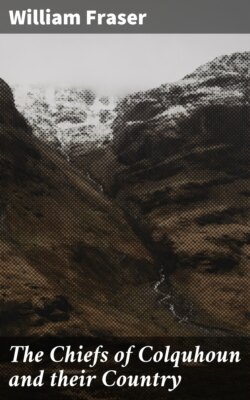Читать книгу The Chiefs of Colquhoun and their Country - Fraser William Alexander - Страница 15
На сайте Литреса книга снята с продажи.
IV.—Sir HUMPHREY OF COLQUHOUN,
Fourth of Colquhoun [1308-1330].
ОглавлениеTable of Contents
Humphrey of Colquhoun, who flourished in the reign of Robert the Bruce, succeeded Ingelramus about the year 1308, and may be presumed to have been his son. He received a charter of the barony of Luss from King Robert the Bruce in 1308, for his special service, and for never having deserted Bruce’s interest. On the 26th April 1309 he was witness to a charter by King Robert the Bruce, which confirmed to Robert Wischart, Bishop of Glasgow, all the churches, lands, rents, possessions, and goods pertaining to that bishop.[1] In this charter he is designated “Vmfredus de Culchoun, miles.”
This charter, dated at Arbroath, to which Humphrey of Colquhoun, knight, was a witness, is worthy of special notice, from its connection with the history of the times in which he lived, and with events in regard to which he doubtless took a deep interest. Robert Wischart, Bishop of Glasgow, in whose favour it was made, was a strenuous defender of the independence of Scotland. When overpowered by circumstances, he, indeed, repeatedly swore fealty to Edward the First of England; but he, as often as circumstances favoured, took part against that hostile invader of his country, against whom he vehemently incited the people to fight. He was amongst the first to join Wallace when he erected the standard against Edward the First; and he equally supported Robert the Bruce when he raised the old war-cry of Scotland against English domination. He absolved Bruce from the anathema of the Church for the slaughter of Comyn in the Church of Dumfries, and took an active part in the preparations made for his coronation. Wischart, however, was taken prisoner by the English in the Castle of Cupar, which he held against them in 1306. One of the charges brought against him was that he had used the timber which Edward the First of England had allowed him for building a steeple to his cathedral, in constructing engines of war against that King’s castles, and especially the Castle of Kirkintolach.[2]
At the time when the above charter was made in his favour the bishop was still in prison; and in the charter King Robert expresses, in affecting terms, his feelings of commiseration towards him under his long and wearisome imprisonment. “Since,” says he, “it would be a pernicious example, and dissonant to reason, to render evil for good, much more since it is a laudable demonstration of gratitude to show favour to those who have deserved well by a suitable recompense, we, deeply pondering, as we are bound, the imprisonment and chains, the persecutions and wearinesses which the venerable father, Lord Robert, by the grace of God, Bishop of Glasgow, has hitherto constantly endured, and still patiently endures, for the rights of the Church and of our Kingdom of Scotland, we have freely granted to the said Lord Bishop all his churches, lands, rents, possessions, and goods.” The bishop, it may be added, was not released till after the battle of Bannockburn, fought on 24th June 1314, when Bruce’s wife, his sister Christian, his daughter Marjory, the young Earl of Mar, his nephew, and the Bishop of Glasgow, were exchanged for the Earl of Hereford, who, on the capitulation of Bothwell Castle by the English into the hands of the Scots, immediately after that battle, became their prisoner.[3] The bishop had grown blind in prison. He survived his liberation only two years, having died in November 1316.
Humphrey of Colquhoun was in the army of Bruce at Bannockburn; and the valour and skill he then displayed attracted the special notice of his sovereign, who granted him a charter of Sauchy, in Stirlingshire, for his good service performed at that battle.
Sir Humphrey of Colquhoun was also witness to a charter by Malcolm Earl of Lennox to John of Luss, granting him certain privileges and immunities within the bounds of his lands of Luss. This charter is undated, but it was confirmed by King Robert on 6th March 1316, from which it may be presumed that it was granted shortly before that date.[4]
There is a Malcolm Culchone who received from King David the Second (1329-1371) a charter of the lands of Gask, and of 13s. 4d. out of the lands of Balmelyn, in the shire of Aberdeen;[5] but whether he was related to Sir Humphrey of Colquhoun we are unable to determine. In 1329 Malcolme of Culchone, who received annually ten pounds from the royal exchequer till he should be otherwise provided for, was paid by the chamberlain, during the last term of his account for that year, the sum of one hundred shillings.[6] In the year 1357 there was paid by Sir Robert of Pebles, the Chamberlain of Scotland, to Malcolme of Culwone, who is probably the same person as in the preceding account, the sum of £6, 13s. 4d. for the King’s use.[7]
| [1] | Registrum Episcopatus Glasguensis, vol. i. p. 220. |
| [2] | Reg. Episc. Glasguensis, vol. i. p. xxxvi. |
| [3] | Tytler’s Hist. of Scotland, vol. i. p. 292. |
| [4] | Cartularium Comitatus de Levenax, p.22. |
| [5] | Robertson’s Index, p. 61, No. 5. |
| [6] | Accounts of the Great Chamberlains of Scotland, printed at Edinburgh, 1836, vol. i. p. 94. |
| [7] | Ibid. vol. i. p. 351. |
